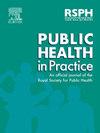Vaping guidance and women's decision-making during pregnancy & postpartum
IF 1.9
Q2 PUBLIC, ENVIRONMENTAL & OCCUPATIONAL HEALTH
引用次数: 0
Abstract
Background
Vaping during pregnancy remains under researched and under reported, making appropriate prevention, health promotion and intervention difficult to design and mount. In this article we assessed the experiences and considerations of women who vape during pregnancy and/or within 2 years post-partum, in order to underpin realistic and informative health information for women and providers in face of conflicting and minimal guidance.
Design
22 interviews were conducted with pregnant and post-partum women who vape(d) nicotine, cannabis, or both during pregnancy and/or after delivery.
Methods
Participants who were pregnant or postpartum were recruited via social media and interviews conducted on Zoom or by telephone, recorded and transcribed. Data were coded in NVivo 12 and analyzed using a combined deductive and inductive approach, and principles of abductive analysis were applied to the data.
Results
Three overarching themes related to decision making about vaping are described: women's agency in information seeking, approaches to assessing information, and ambivalence regarding vaping practices. Women looked for information on the health effects of vaping during pregnancy and made differing decisions in the context of limited research and guidance. At times, family, friends, partners, and internet resources influenced their decisions. Some women dealt with ambivalence by vaping only in private, while alone, and at home or as a convenience. The women were uniformly aware of societal judgement regarding pregnancy and substance use in general and feared being addressed by friends or strangers about vaping.
Conclusion
In the absence of definitive research and unambiguous clinical guidance, the women felt limited in finding accurate advice, but demonstrated agency in information seeking and assessment. Nonetheless, they also recounted their ambivalence regarding their vaping decisions and practices. We created varied knowledge information products to fill this void.
孕期和产后的电子烟指导和女性决策。
背景:怀孕期间吸电子烟的研究和报道尚不充分,因此难以设计和实施适当的预防、健康促进和干预措施。在这篇文章中,我们评估了在怀孕期间和/或产后2年内使用电子烟的妇女的经历和考虑,以便为妇女和提供者在面临冲突和最低指导的情况下提供现实和翔实的健康信息。设计:对22名在怀孕和/或分娩后吸食尼古丁、大麻或两者同时吸食的孕妇和产后妇女进行了访谈。方法:通过社交媒体和Zoom或电话访谈的方式招募孕妇或产后参与者,并进行录音和转录。数据在NVivo 12中编码,采用演绎和归纳相结合的方法进行分析,并应用溯因分析原则对数据进行分析。结果:描述了与电子烟决策相关的三个主要主题:女性在信息寻求中的代理,评估信息的方法,以及对电子烟实践的矛盾心理。女性在怀孕期间寻找有关电子烟对健康影响的信息,并在有限的研究和指导下做出了不同的决定。有时,家人、朋友、伴侣和互联网资源会影响他们的决定。一些女性为了应对矛盾心理,只在私下、独自一人、在家或为了方便而吸电子烟。这些女性普遍意识到社会对怀孕和药物使用的评判,并且害怕被朋友或陌生人谈论电子烟。结论:在缺乏明确的研究和明确的临床指导的情况下,女性在寻找准确的建议方面感到有限,但在信息寻求和评估方面表现出代理作用。尽管如此,他们也讲述了自己对电子烟的决定和做法的矛盾心理。我们创造了各种知识信息产品来填补这一空白。
本文章由计算机程序翻译,如有差异,请以英文原文为准。
求助全文
约1分钟内获得全文
求助全文

 求助内容:
求助内容: 应助结果提醒方式:
应助结果提醒方式:


